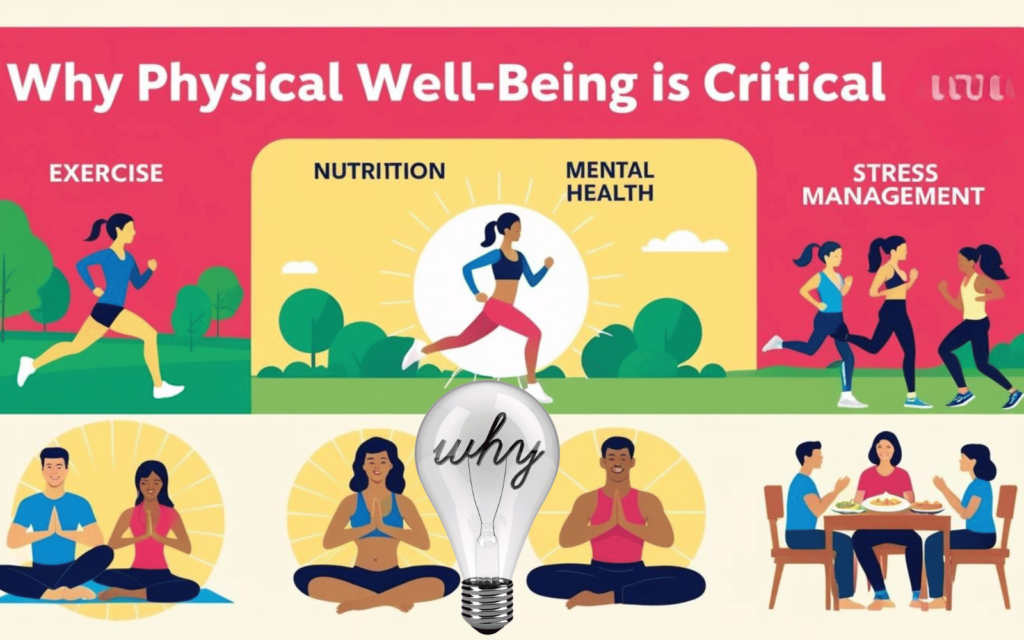The Importance of Physical Well-Being at Work for Employee Success

Did you know that employees spend about half their waking hours at work? Thus, the workplace is a critical space for promoting physical well-being.
Whether it’s offering wellness programs or encouraging employees to adopt healthier habits, prioritizing physical and mental health at work directly impacts productivity, engagement, and overall health.
This article explores why the importance of physical well-being at work cannot be overstated and how businesses can embrace a holistic approach to improving employee health.
From boosting energy levels to reducing stress, taking care of employee physical health benefits everyone – from workers to employers to the organization’s culture.
Key Takeaways
- Physical well-being enhances energy, focus, and productivity at work.
- Healthier employees have fewer sick days, reduced stress, and improved mental health.
- Employers and employees share the responsibility for creating a healthier workplace.
- Encouraging wellness programs, healthy eating, and physical activity improves overall employee well-being.
- A strong workplace culture that promotes health leads to happier and more engaged workers.
Why Physical Well-Being Is Critical in the Workplace

A person’s physical and mental health is closely tied to their performance at work. Long hours, poor eating habits, and physical inactivity can lead to fatigue, higher stress levels, and illnesses like heart disease.
However, businesses can create a healthier workplace culture focusing on employee wellbeing.
How Physical Well-Being Benefits Employees and Employers
- Boosts Productivity: Healthy employees have higher energy levels, better focus, and increased output.
- Reduces Sick Days: Encouraging physical activity and reducing stress leads to fewer sick leave requests.
- Supports Work-Life Balance: Promoting well-being at work helps employees manage their well-being better.
- Builds Trust and Engagement: Workers feel valued when employers focus on their health. This boosts employee engagement.
- Improves Organizational Culture: Wellness-focused initiatives foster positive workplace culture and collaboration.
1. Designing a Healthy Work Environment

A supportive and healthy workplace isn’t just about aesthetics-it’s about creating an environment that prioritizes physical and mental health.
Actions for Employers
- Implement Policies for Health Promotion: Introduce clear guidelines supporting employee physical health and wellness.
- Offer Ergonomic Solutions: Provide standing desks, ergonomic chairs, and proper lighting to improve work comfort.
- Encourage Breaks: Ensure workers step away from desks to stretch or take walks to prevent physical inactivity.
- Promote a Holistic Approach to Health: Workplace wellness programs should include financial well-being, occupational health, and fitness programs.
Actions for Employees
- Set Up an Ergonomic Desk: Adjust your workspace to avoid neck and back strain.
- Stay Active During Work Hours by Walking to a coworker’s desk instead of sending an email or taking the stairs instead of the elevator.
- Practice Healthy Habits: Stretch regularly and stay hydrated to maintain energy levels throughout the day.
2. Physical Activity at Work: A Game-Changer

Physical activity improves physical and mental health, reduces stress, and increases energy levels. However, modern work demands often make it hard to stay active.
Simple Ways to Stay Active at Work
- Walking Breaks: Take a quick walk around the office or outside during lunch breaks.
- Regular Exercise Challenges: Encourage employees to participate in friendly fitness competitions to create healthy competition and higher productivity.
- Use Fitness Programs: Participate in company-sponsored fitness programs or local gym memberships.
- Stretch During Work Hours: Quick desk exercises or chair yoga can reduce stiffness and physical inactivity.
A physically active workforce can combat heart disease and fatigue while promoting higher energy levels and improved performance.
3. Healthy Eating for a Productive Workday

What we eat fuels our energy and focus. Poor nutrition can lead to fatigue, while healthy eating ensures sustained energy and productivity.
Tips for Employees
- Bring Healthy Snacks: Choose options like fruits, nuts, and yogurt over chips and candy.
- Meal Prep for Work: Preparing meals ensures balanced nutrition and helps avoid fast food.
- Stay Hydrated: Keep a water bottle handy to stay refreshed.
- Limit Sugary Drinks: Opt for herbal teas or water to maintain consistent energy levels.
How Employers Can Encourage Healthy Eating
- Provide Healthy Foods in the Office: Stock breakrooms with healthy snacks to support healthier employees.
- Host Wellness Workshops: Educate employees on meal planning, nutrition, and the benefits of healthy eating.
- Encourage Lunch Breaks: Workers should take proper lunch breaks instead of skipping meals or eating at desks.
4. Managing Stress to Improve Well-Being

Stress is one of the biggest obstacles to employee health. Without proper stress management, mental health and physical well-being suffer, leading to decreased productivity and more sick days.
Reducing Stress at Work
- Practice Mindfulness: Techniques like deep breathing or meditation can help calm the mind.
- Create a Balanced Job Design: Manage work demands by setting realistic deadlines and goals.
- Support Workers: Encourage senior leaders to build team trust and foster open communication.
- Encourage Work-Life Balance: Flexible schedules or remote work policies support employees’ well-being.
When stress is reduced, employees experience improved mental health, better energy levels, and greater job satisfaction.
5. Building a Workplace Culture Focused on Health

A healthy workplace culture is good for employees and the business. Companies with strong wellness programs see higher engagement, retention, and productivity.
Steps to Build a Healthy Workplace
- Promote Wellness Programs: Offer resources like mental health support, physical fitness classes, or stress-reduction workshops.
- Recognize Efforts: Celebrate healthier employees who take steps to improve their physical and mental health.
- Lead by Example: Senior leaders should participate in fitness programs or healthy competition challenges to motivate their teams.
- Encourage Collaboration: Foster connections between coworkers to build trust and promote teamwork.
A workplace culture that prioritizes health builds loyalty, improves employee engagement, and supports a holistic approach to work-life success.
Summary
Physical well-being at work is important in its undeniable impact on employee success. When organizations focus on improving employee health, they see benefits like reduced sick days, better energy levels, and increased productivity.
Creating a healthy workplace culture involves supporting employees through wellness programs, nutritious foods, physical activity, and stress management.
Whether offering fitness programs or encouraging regular exercise, the business case for prioritizing health promotion is clear. A healthy workforce leads to happier, healthier, and more engaged employees.
Frequently Asked Questions
What Is the Importance of Physical Well-Being at Work?
Physical well-being boosts productivity, reduces stress, and supports physical and mental health, making it essential for employee success.
How Can Employers Encourage Employee Wellbeing?
Employers can promote health through wellness programs, healthier foods, ergonomic work environments, and flexible schedules.
How Does Physical Activity Improve Employee Health?
Regular exercise combats physical inactivity reduces stress and boosts energy levels, which improves overall health and job performance.
Why Is Workplace Culture Important for Employee Engagement?
A positive workplace culture fosters trust, collaboration, and motivation, encouraging employees to care for their health and perform better.
What Are the Benefits of a Holistic Approach to Health at Work?
A holistic approach addresses physical, mental, and financial well-being, leading to healthier employees, fewer sick days, and higher productivity.






2 Comments